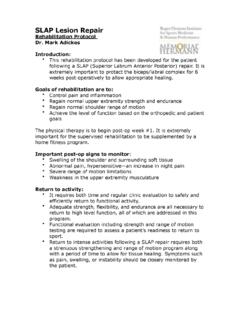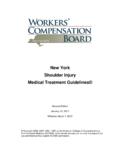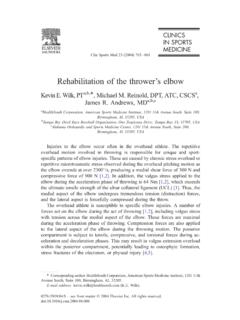Transcription of Total Shoulder Arthroplasty/Hemiarthroplasty …
1 COSM rehabilitation PAGE. PROTOCOL 1 OF 7. REHAB. Total Shoulder Indiana DEVELOPED: arthroplasty / Punxsutawney 1/2006. hemiarthroplasty Clarion REVISED: PROTOCOL. Special note: This protocol is only a guideline and not intended to substitute for appropriate clinical decision making by the clinician. If a clinician requires assistance, the clinician should consult with the referring surgeon. Total Shoulder Arthroplasty/Hemiarthroplasty Protocol**. The intent of this protocol is to provide the clinician with a guideline of the postoperative rehabilitation course of a patient that has undergone a Total Shoulder arthroplasty (TSA). or hemiarthroplasty (humeral head replacement [HHR]). It is not intended to be a substitute for appropriate clinical decision making regarding the progression of a patient's postoperative course.
2 The actual postsurgical physical therapy management must be based on the surgical approach, physical exam/findings, individual progress, and/or the presence of postoperative complications. If a clinician requires assistance in the progression of a patient postsurgery, the clinician should consult with the referring surgeon. Please note: Patients with a concomitant repair of a rotator cuff tear and/or a TSA/HHR. secondary to fracture or cuff arthropathy should be progressed to the next phase, based on meeting the clinical criteria (not based on the postoperative time frames) as appropriate in collaboration with the referring surgeon. The given time frames are an approximate guide for progression, achieving the clinical criteria should guide the clinician and patient through this protocol. Joint Specific Outcome Measure Upon the start of postoperative care the patient and therapist complete the Simple Shoulder Test during their first ambulatory visit.
3 This assessment measure is then completed every 30 days and upon discharge from physical therapy, in conjunction with routine re-evaluations to assist in assessing progress. Phase I: Immediate Postsurgical Phase Goals: Allow healing of soft tissue Maintain integrity of replaced joint Gradually increase passive range of motion (PROM) of Shoulder ; restore active range of motion (AROM) of elbow/ wrist/ hand Reduce pain and inflammation Reduce muscular inhibition Independence with activities of daily living (ADLs) with modifications, while maintaining the integrity of the replaced joint Precautions: Sling should be worn continuously for 3 to 4 weeks While lying supine, a small pillow or towel roll should be placed behind the elbow to avoid Shoulder hyperextension/ anterior capsule stretch/ subscapularis stretch Avoid Shoulder AROM.
4 No lifting of objects No excessive Shoulder motion behind back, especially into internal rotation (IR). No excessive stretching or sudden movements (particularly external rotation [ER]). No supporting of body weight by hand on involved side Keep incision clean and dry (no soaking for 2 weeks). No driving for 3 weeks Postoperative Day 1 (in Hospital). Passive forward flexion in supine to tolerance Gentle ER in scapular plane to available PROM (as documented in operative note), usually around 30 (attention: DO NOT produce undue stress on the anterior joint capsule, particularly with Shoulder in extension). Passive IR to chest Active distal extremity exercise (elbow, wrist, hand). Pendulum exercises Frequent cryotherapy for pain, swelling, and inflammation management Patient education regarding proper positioning and joint protection techniques Early Phase I (out of Hospital).
5 Continue above exercises Begin scapula musculature isometrics/ sets (primarily retraction). Continue active elbow ROM. Continue cryotherapy as much as able for pain and inflammation management Late Phase I. Continue previous exercises Continue to progress PROM as motion allows Begin assisted flexion, abduction, ER, IR in the scapular plane Progress active distal extremity exercise to strengthening as appropriate Criteria for progression to the next phase (II): Tolerates PROM program Achieves at least 90 PROM flexion Achieves at least 90 PROM abduction Achieves at least 45 PROM ER in plane of scapula Achieves at least 70 PROM IR in plane of scapula measured at 30 of abduction Phase II: Early Strengthening Phase (Not to begin before 4 to 6 weeks postsurgery to allow for appropriate soft tissue healing.). Goals: Restore full passive ROM.
6 Gradually restore active motion Control pain and inflammation Allow continue healing of soft tissue Do not overstress healing tissue Re-establish dynamic Shoulder stability Precautions: Sling should only be used for sleeping and removed gradually over the course of the next 2 weeks, for periods throughout the day While lying supine, a small pillow or towel should be placed behind the elbow to avoid Shoulder hyperextension/anterior capsule stretch In the presence of poor Shoulder mechanics avoid repetitive Shoulder AROM exercises/active against gravity in standing No heavy lifting of objects (no heavier than coffee cup). No supporting of body weight by hand on involved side No sudden jerking motions Early Phase II. Continue with PROM, active assisted range of motion (AAROM). Begin active flexion, IR, ER, abduction pain-free ROM.
7 AAROM pulleys (flexion and abduction), as long as greater than 90 of PROM. Begin Shoulder submaximal pain-free Shoulder isometrics in neutral Scapular strengthening exercises as appropriate Begin assisted horizontal adduction Progress distal extremity exercises with light resistance as appropriate Gentle glenohumeral and scapulothoracic joint mobilizations as indicated Initiate glenohumeral and scapulothoracic rhythmic stabilization Continue use of cryotherapy for pain and inflammation Late Phase II. Progress scapular strengthening exercises Criteria for progression to the next phase (III): Tolerates PROM/AAROM isometric program Achieves at least 140 PROM flexion Achieves at least 120 PROM abduction Achieves at least 60 PROM ER in plane of scapula Achieves at least 70 PROM IR in plane of scapula measured at 30 of abduction Able to actively elevate Shoulder against gravity with good mechanics to 100.
8 Phase III: Moderate Strengthening (Not to begin before 6 weeks postsurgery to allow for appropriate soft tissue healing and to ensure adequate ROM.). Goals: Gradual restoration of Shoulder strength, power, and endurance Optimize neuromuscular control Gradual return to functional activities with involved upper extremity Precautions: No heavy lifting of objects (no heavier than 3 kg). No sudden lifting or pushing activities No sudden jerking motions Early Phase III. Progress AROM exercise/activity as appropriate Advance PROM to stretching as appropriate Continue PROM as needed to maintain ROM. Initiate assisted Shoulder IR behind back stretch Resisted Shoulder IR, ER in scapular plane Begin light functional activities Wean from sling completely Begin progressive supine active elevation strengthening (anterior deltoid) with light weights ( kg) at variable degrees of elevation Late Phase III.
9 Resisted flexion, abduction, extension (Therabands/ sport cords). Continue progressing IR, ER strengthening Progress IR stretch behind back from AAROM to AROM, as ROM allows (Pay particular attention as to avoid stress on the anterior capsule.). Criteria for progression to the next phase (IV): Tolerates AAROM/ AROM/ strengthening Achieves at least 140 AROM flexion supine Achieves at least 120 AROM abduction supine Achieves at least 60 AROM ER in plane of scapula supine Achieves at least 70 AROM IR in plane of scapula supine in 30 of abduction Able to actively elevate Shoulder against gravity with good mechanics to at least 120 . Note: If above ROM are not met, then patient is ready to progress when the patient's ROM is consistent with outcomes for patients with the given underlying pathology. Phase IV: Advanced Strengthening Phase (Not to begin before 12 weeks to allow for appropriate soft tissue healing and to ensure adequate ROM.)
10 Goals: Maintain nonpainful AROM. Enhance functional use of upper extremity Improve muscular strength, power, and endurance Gradual return to more advanced functional activities Progress weight-bearing exercises as appropriate Precautions: Avoid exercise and functional activities that put stress on the anterior capsule and surrounding structures (eg, no combined ER and abduction above 80 of abduction). Ensure gradual progression of strengthening Early Phase IV. Typically patient is on a home exercise program by this point to be performed 3 to 4 times per week Gradually progress strengthening program Gradual return to moderately challenging functional activities Late Phase IV (Typically 4 to 6 Months Postoperative). Return to recreational hobbies, gardening, sports, golf, doubles tennis Criteria for discharge from skilled therapy: Patient able to maintain nonpainful AROM.






